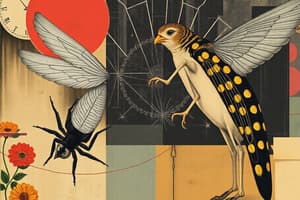Podcast
Questions and Answers
What is the fitness equation for a successful mutualist?
What is the fitness equation for a successful mutualist?
- Fsm = Benefit + Cost
- Fsm = Benefit - Cost (correct)
- Fsm = Value - Cost
- Fsm = Cost + Value
Which of the following accurately describes the relationship established in mycorrhizae?
Which of the following accurately describes the relationship established in mycorrhizae?
- Plants exchange water with soil nutrients.
- Fungi exchange nutrients with soil bacteria.
- Plants exchange soil resources with fungi. (correct)
- Fungi exchange carbon dioxide with plants.
What is the condition for the fitness of non-mutualists?
What is the condition for the fitness of non-mutualists?
- Fm = 0 (correct)
- Fm = Benefit - Cost
- Fm = -Cost
- Fm = Benefit + Cost
Which type of mycorrhizae penetrates plant cells?
Which type of mycorrhizae penetrates plant cells?
Which statement correctly describes the fitness equation for an unsuccessful mutualist?
Which statement correctly describes the fitness equation for an unsuccessful mutualist?
What does the equation p(Fsm) + q(Fum) represent?
What does the equation p(Fsm) + q(Fum) represent?
Which species was noted for having specialized structures for pollination gathering before the appearance of angiosperms?
Which species was noted for having specialized structures for pollination gathering before the appearance of angiosperms?
What does the term 'p(Fsm)' represent in the context of mutualism?
What does the term 'p(Fsm)' represent in the context of mutualism?
What is one of the primary benefits for plants in a mycorrhizae relationship?
What is one of the primary benefits for plants in a mycorrhizae relationship?
What is a defining characteristic of ectomycorrhizae?
What is a defining characteristic of ectomycorrhizae?
What role do nectar guides play in flowering plants?
What role do nectar guides play in flowering plants?
Which best describes reciprocal selection in mutualisms?
Which best describes reciprocal selection in mutualisms?
How does frugivory contribute to seed dispersal?
How does frugivory contribute to seed dispersal?
What is indicated by the 'latitudinal gradient' in species richness?
What is indicated by the 'latitudinal gradient' in species richness?
Which factor is NOT considered in explaining geographical variations in species richness?
Which factor is NOT considered in explaining geographical variations in species richness?
How is the species-area relationship defined?
How is the species-area relationship defined?
What is a significant characteristic of the individualistic view of communities?
What is a significant characteristic of the individualistic view of communities?
Which mechanism is described as aiding in seed germination through animal digestion?
Which mechanism is described as aiding in seed germination through animal digestion?
What does the log-log model of species richness represent?
What does the log-log model of species richness represent?
What is the primary function of an angiosperm's fruit?
What is the primary function of an angiosperm's fruit?
Flashcards
Mutualism
Mutualism
A relationship between two species where both benefit.
Fitness
Fitness
The survival and reproductive success of an organism.
Cost in Mutualism
Cost in Mutualism
The resources or energy spent by an organism participating in a mutualistic relationship.
Benefit in Mutualism
Benefit in Mutualism
Signup and view all the flashcards
Successful Mutualist
Successful Mutualist
Signup and view all the flashcards
Unsuccessful Mutualist
Unsuccessful Mutualist
Signup and view all the flashcards
Mycorrhizae
Mycorrhizae
Signup and view all the flashcards
Endomycorrhizae
Endomycorrhizae
Signup and view all the flashcards
Ectomycorrhizae
Ectomycorrhizae
Signup and view all the flashcards
Pollination
Pollination
Signup and view all the flashcards
Adaptation & Pollination
Adaptation & Pollination
Signup and view all the flashcards
Frugivory
Frugivory
Signup and view all the flashcards
Seed Dispersal Mechanism
Seed Dispersal Mechanism
Signup and view all the flashcards
Scarification
Scarification
Signup and view all the flashcards
Reciprocal Selection
Reciprocal Selection
Signup and view all the flashcards
Diffuse Selection
Diffuse Selection
Signup and view all the flashcards
Ecological Community
Ecological Community
Signup and view all the flashcards
Holistic View of Communities
Holistic View of Communities
Signup and view all the flashcards
Individualistic View of Communities
Individualistic View of Communities
Signup and view all the flashcards
Emergent Properties of Communities
Emergent Properties of Communities
Signup and view all the flashcards
Study Notes
Mutualism Costs and Benefits
- Fitness for non-mutualists (Fm) = 0
- Fitness for successful mutualists (Fsm) = Benefit - Cost
- Fitness for unsuccessful mutualists (Fum) = -Cost
- p(Fsm) = frequency of successful mutualists
- q(Fum) = frequency of unsuccessful mutualists
- p(Fsm) + q(Fum) = benefit relative to cost
- p(Fsm) + q(Fum) > 0
Mycorrhizae
- Mutualistic symbiosis between plants and fungi
- Exchange of sugars from plants for soil resources
- Two types:
- Endomycorrhizae (arbuscular), penetrating plant cells
- Ectomycorrhizae, forming a sheath around roots and penetrating between cells
Pollination
- Various insects collect pollen from gymnosperms (before angiosperms)
- Thrips (pre-angiosperms) have specialized structures for pollen gathering
- Flowers evolved in response to relationships with pollinators
- Flowers have structures to attract pollinators (anthers, filaments, nectar guides)
Frugivory
- Seed dispersal mechanism involving vertebrate animals and angiosperm plants
- Example: Black Cherry and birds (dispersal, frugivory)
- Seed excretion (excretion) aids germination by scarification
Reciprocal and Diffuse Selection
- Reciprocal selection: mutualism showing specificity between interacting populations
- Diffuse Selection: networks of interacting species where mutualists benefit from many interactions
Community Ecology
- Holistic View: treats communities as integrated organisms (with climax communities)
- Individualistic View: sees communities as collections of species whose presence depends on environmental factors
Species Richness
- Species richness varies geographically, increasing towards the equator
- Area larger at equator allows for more populations and ranges for speciation
- Tropical ecosystems have longer evolutionary histories, with more closely related species evolving faster
Species-Area Relationships
- Species richness increases with increasing survey area (area)
- Log-Log model for species-area relationship: Log S = Log C + z Log A
Assessing Species Richness - Species Surveys
- Rarefaction: technique to compare richness & assessing outcome of species surveys
- As more samples are taken, the number of species increase approaching/reaching an asymptote. Graph with x-axis = number of sites sampled and y-axis the average number of species encountered
Comparing Species Assemblages
- Ecological distance: Quantified difference between two entities based on set of variables
- MRPP (Multiple Response Permutation Procedure) groups sites based on similar species assemblages
Disturbance and Succession
- Disturbance affects species richness, impacting biomass accumulation
- High disturbance areas have less biomass, and low disturbance environments with high species richness.
- Succession: predictable series of changes after disturbance;
- Establishment: early species establish changing conditions
- Facilitation: early species benefits later species, creating more favorable conditions.
- Inhibition: late-arriving species inhibit the establishment of earlier species.
Trophic Relationships
- Herbivores, predators, and bottom-up (autotrophs influencing heterotrophs, or top-down (predators influencing their prey) trophic relationships regulate communities.
- Succession changes species compositions in response to disturbance and resource availability in an area.
Stability and Richness
- Communities with more interactions (species) are generally more stable that those with more trophic interactions.
- Invasions: non-native species that, when introduced to an area, may quickly spread and replace native plant or animal communities potentially disrupting existing relationships.
Studying That Suits You
Use AI to generate personalized quizzes and flashcards to suit your learning preferences.
Related Documents
Description
This quiz explores the concepts of mutualism, focusing on costs and benefits for mutualists in ecological systems. From mycorrhizae to pollination and frugivory, understand how different organisms interact and benefit from these relationships. Test your knowledge on the intricate dynamics of these symbiotic partnerships.




